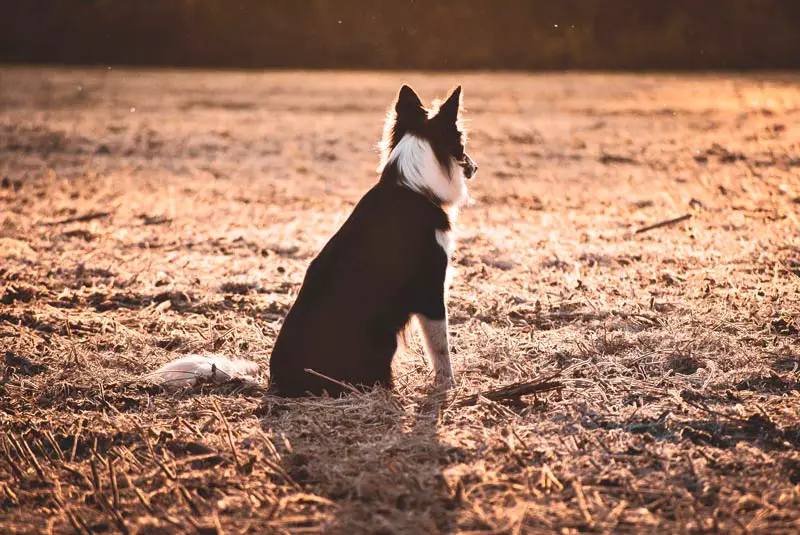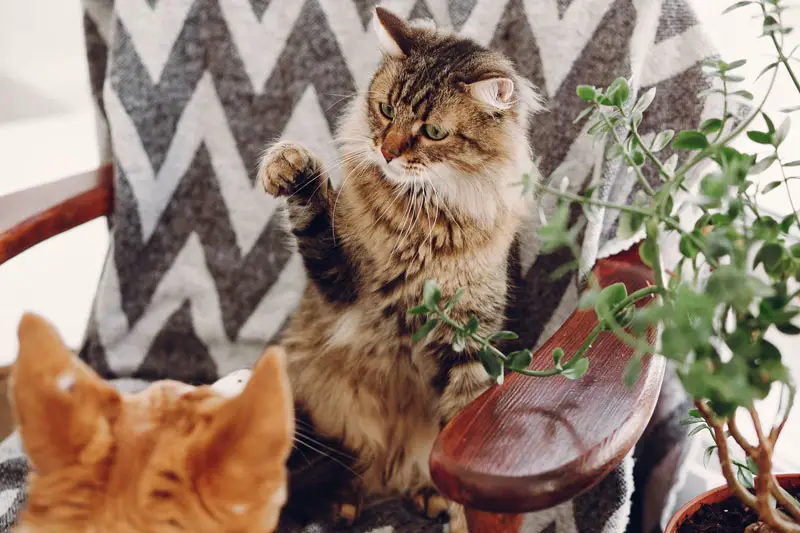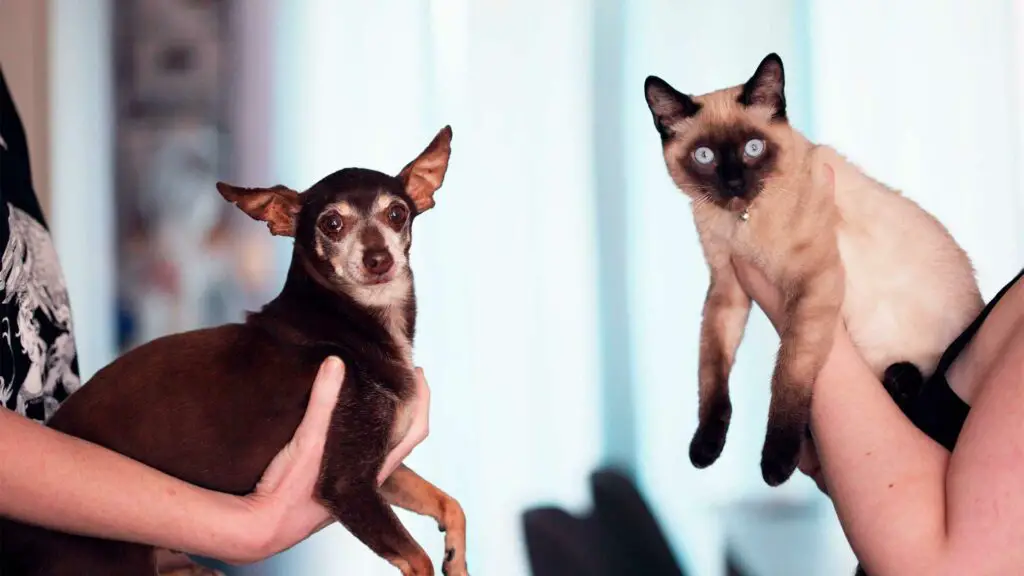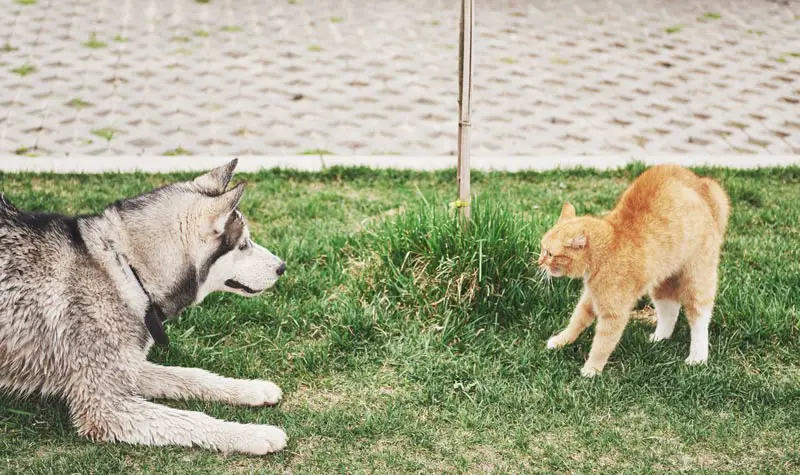You’ve heard the expression “fight like cats and dogs.” There’s a reason for the expression. Instinctively, cats and dogs don’t always get along. This doesn’t mean they can’t, though! Actually, cats and dogs can become close friends. A big part of building this sort of relationship, though, is introducing them to each other properly.
If you have a cat, they are used to having the house to themselves. They probably prance around like they own the place! Unless they have previously lived with dogs, seeing a new dog in the house is going to be a shock to them.
Your new dog will also need some time to adjust. Even if they’ve gotten along with cats in the past, they don’t know your cat, and they are also trying to get used to your family and you. This all takes time and can put an enormous amount of stress on your new dog. The key is to make sure your dog settles in comfortably and your cat has the opportunity to adjust.
Can Cats and Dogs Get Along?

Yes! Cats and dogs can get along. If nothing else, they can learn to tolerate each other. With that said, many cats and dogs can become friends. This is especially so if they are introduced while they are young. It’s best to socialize dogs with cats and vice versa, if possible, when they are puppies/kittens. If you can’t, though, you can still introduce them later in life. Just understand that there will be certain challenges you must face.
Tips for Introducing Your Cat to Your New Dog

Dogs and cats can get along famously—if you introduce them to each other properly. With that said, when you go to pick out your new pup, take a look at their history. If they have a history of not getting along with cats, you may want to consider a different dog. Trying to introduce them can be problematic and difficult. If the dog has no experience with cats, it may be easier.
If you have the option to get a puppy, it can be a lot easier to train your new pup to get along with your kitty. Your puppy doesn’t have previous experience, so they don’t have negative interactions with cats. If they are adults, though, you can still train them.
Below are some tips you can follow for introducing a new dog to your home when you have a cat already residing there…
Separate Your Pets
When you first bring your new dog into your home, you’ll want to make sure they have the ability to explore uninterrupted. They also need a space that they feel is safe so they can decompress after exploring. You don’t want your new dog exploring with your cat freaking out about the “intruder.” Put your cat in a separate area from your dog and make sure they have their separate spaces for a little bit while they get used to each other.
Generally, a day or two should be enough time for your pets to initially get acclimated. After this time, you can start with the next step.
Allow Them to Smell Each Other
Smell is an extremely important sense for animals. You see them sniffing each other all the time. Your new dog will love to get a nice whiff as soon as you get home, and they will want to smell other pups as well. With how important scent is, you will want to give your pets a chance to “shake hands” through their scent.
Place towels around where your dog and cat sleep. Then, switch out the towels. This gives the two pets the chance to get used to the smell. If there is a common area, they will also get the chance to smell each other (while they are separated).
Play Separately

You will want your pets to get the chance to hear each other next. To do this, make sure they are separated by a door. You can play with your new pup and train them. On the other side of the door, make sure your kitty is getting plenty of love and treats as well. Make the time they spend playing separately as fun and positive as possible.
While they may be hyper-focused on the pet on the other side of the door at first, they’ll slowly acclimate.
Let Them Take a Peek
For this step, it’s extremely important to get a solid pet gate. This is especially so if you have a bigger dog. Don’t try to save money on a weak gate that your dog will be able to knock over. Once you’ve installed your pet gate, you can continue to interact with the two pets separately. Use a towel or blanket to cover the gate so they don’t see each other but hear each other and essentially share the same space.
Over time, give the pets a little peek by moving the blanket or towel aside. Slowly move the towel or blanket aside and keep each pet’s attention with play. If either pet starts to get aggressive, give them some downtime.
It’s important to be patient during this phase. A lot of pet owners want to jump the gun and move forward. This isn’t a good idea. If they are both used to living with dogs/cats, then it may be an easier process. If not, this can take time.
Expect it to take a few weeks of practice before they can hang out in the same space with a gate and no blanket. Even then, they need some time to get used to seeing each other through the fence and being comfortable.
Remember—stop exposure if either pet gets scared or starts acting aggressively. There is always tomorrow. There’s no rush!
Give Them Limited Access to Each Other

Once your dog and cat can cohabitate and live in the same space comfortably, you can start the next phase. For this step, you’ll have the gate open but keep your dog on a leash. Make sure you give them both treats and play with them separately. Over time, your cat may walk up to your dog and say, “Hello.” This is a good sign! With that said, don’t let your dog lead the dance. Allow your cat the chance to explore. If there are any signs of fear or aggression, separate them again and try later. Don’t let these signs slide because you are so excited for them to finally live together.
Keep doing this slowly until your pets start to get used to sharing the same space. The goal is for them to both be calm and accepting of the other pet being in the same space. Eventually, you’ll be able to explore having them in the same space off-leash. Even then, keep a very close eye on them. If there are signs of fear or aggression, separate them immediately.
Over time they’ll learn to tolerate each other. Over a longer period of time, they may become close friends!

If They Don’t Get Along
At any stage of the process, your pets may not get along. That’s normal. It just means they need more time. If you move ahead and they start showing signs of fear and aggression, take a step back and move to the previous stage. For instance, if you allow them to see each other and your dog starts freaking out, you may need to move back to a covered gate.
If progress is going nowhere after a few weeks or months, you may want to consider taking them to a trainer and consulting a specialist. Your dog may also benefit from obedience training. Training and exercise will greatly improve your dog’s ability to focus on the task at hand and stay calm.
Watch for Body Language
Once you start introducing the pets to each other, it’s extremely important to focus on body language cues. These include:
Dog
- Growling
- Showing teeth
- Licking lips
- Yawning
- Looking away
- Ears back
- Tail tucked
Cat
- Arched back
- Ears flattened
- Tail tucked
- Hissing
- Hiding
- Crouching
- Facing sideways
If you notice these signs from either of your pets, it’s time to take action. Don’t wait around for it to pass. Separate them. You can always try again later. Remember—there is NO rush!
Another thing you’ll want to keep in mind is your own body language. Pets (especially dogs) pick up on your body language. If you are nervous, they will see and smell it! They can even detect changes in heart rate. Stay calm and keep the interactions positive and pleasant.
Reach Out to Stayyy!
If you have a new dog, it’s important to ensure they get properly trained. If you would like to ensure they have the best training possible, reach out to Stayyy! We will work with your new dog and help them to learn commands and good behaviors. We will also focus on socializing them.
Be patient and before you know it, your new dog and kitty will be hanging out in harmony.



